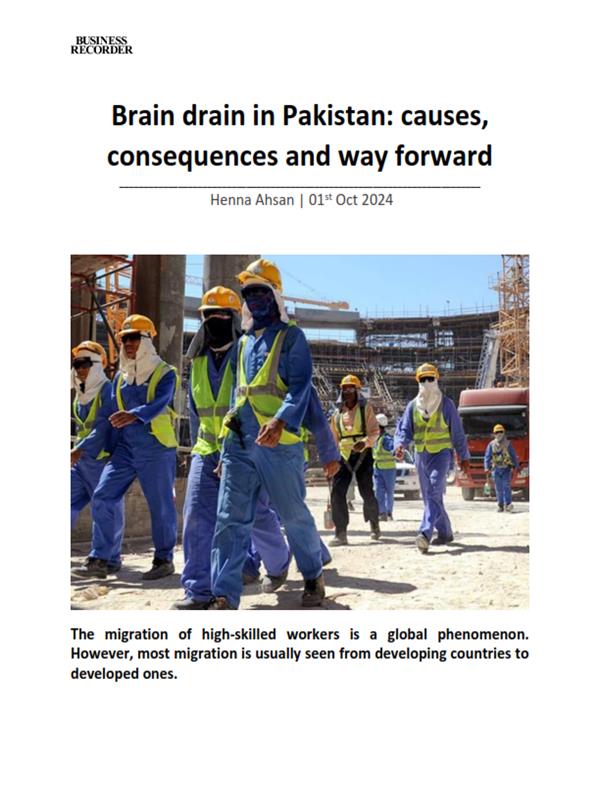
Pakistan Institute of Development Economics
- Home
Our Portals
MenuMenuMenuMenuMenuMenuMenu - ResearchMenuMenuMenuMenuMenuMenuMenu
- Discourse
- The PDR
- Our Researchers
- Academics
- Degree Verification
- Thesis Portal
- Our Portals
Brain drain in Pakistan: causes, consequences and way forward
The migration of high-skilled workers is a global phenomenon. However, most migration is usually seen from developing countries to developed ones.
World Bank 2023 report shows that migration of highly skilled people from high-income countries is 4 percent of the skilled lot, for middle-income countries this value is slightly over 10 percent, and for low-income countries, it is 20 percent.
Brain drain is a growing concern for developing countries like Pakistan, as these countries invest heavily in the education and training of their youth.
However, significant resources are lost when these individuals migrate, and the recipient states benefit directly from these migrations as they haven’t paid any cost. Any nation’s intellectuals are among its most expensive assets due to their training, which involves both time and material costs, but more significantly, lost opportunities.
One of the pioneer studies by Dr Nadeem ul Haque, VC PIDE, highlighted the possible reasons behind the problem. As per him, poor governance infrastructure, including inadequate personal protection, unclean surroundings, and subpar child-rearing facilities, are frequently cited causes for this brain drain. Moreover, non-comparative wage rates and lack of job opportunities for highly educated individuals are some other reasons that motivate people to migrate from the country.
Keeping in mind the severity of the issue, a lot of work has been done by PIDE in the last five years under the mentorship of Dr. Haque. To know what the public thinks about this phenomenon, PIDE’s pioneer work by Dr Duree Nayab in year 2022 is an important source to consult.
The findings of her survey show that 37% of the people in Pakistan want to leave the country. One of her interesting findings is that educated people are more interested in leaving Pakistan as compared to low-educated ones. The study of Ahsan and Khan (2024) from PIDE complements these findings and shows that graduate unemployment in Pakistan is 16 % whereas the overall unemployment rate is 5%.
Haque and Nayab (2021) from PIDE point out that 31 percent of the youth with degrees, including professional ones, are unemployed, with females’ unemployment at 51 percent and males’ at 16 percent. Rural graduate unemployment is even much higher than urban, begging the question of mobility. In PIDE’s basic survey, a similar opinion came to light as 78% of the participants wanted to leave the country for better income.
Dr. Shahid from PIDE, in one of his studies, argues that there is no space in the country for creative thinkers and individuals with cutting-edge abilities. Instead, the hierarchical and colonial mindset prevailing in the institutions suggests that there is no need for high-caliber human capital. It is challenging to develop and produce high-quality human capital in such an atmosphere, and it is also challenging to hold onto it for an extended period.
The critical importance of this brain drain becomes more visible when we analyze its possible consequences and impacts. Again, PIDE took the lead in it and the seminal work done by Khan and Ahmad (2024) calculated the economic cost to Pakistan for the talent lost because of brain drain.
The numerous facets of Pakistan’s talent loss were investigated in this study. By taking both explicit and implicit costs into account, they estimated the economic impact of this talent loss. Additionally, they also analyzed the decline in production capability of a nation due to this brain drain. Their results show that the cost to the country of origin becomes significantly high when productivity loss is considered.
Immigrants often contribute to the GDP of destination countries through their work and productivity, resulting in considerable economic losses at origin countries. As per their calculation, which is based on migrants’ contribution to global GDP subtracting remittances received, Pakistan suffered a productivity loss of US $ 303.4 billion in just year 2023.
Human capital and intellectuals that are an important source for the growth of low-income countries have left the country and half of these are in queue to follow suit. So, there is a need to effectively deal with the problem by adopting a comprehensive strategy that addresses the root-cause of the problem and creates a conducive climate for retaining and using highly talented workers to contribute to the country’s progress.
For this the government needs to introduce such policies that enhance local opportunities for better job prospects through investment in industries, innovation, and entrepreneurship as this may retain and also attract talent back. To move along the course PIDE reforms agenda (2021) led by Dr Haque would be a good guide to consult and start the process.
The agenda emphasizes removing over-regulation and over-documentation in public ministries and departments as it hinders many startups from taking off. Not surprising that Pakistan ranks too low in all indices related to ease of business and competitiveness.
The agenda further emphasizes to reduce government footprint in the economy, which is currently 67%, as it is a big obstacle in offering equal opportunities to all market players and ensuring open and fair competition.
Finally, the PIDE report “Opportunity to Excel: Now and the Future” by Haque and Nayab (2021) ascertains a talent focused opportunity approach that may permit creativity and entrepreneurship to prosper everywhere. This could result in a network of activities and many fresh ideas and as a result an increase in GDP due to collaboration with global talent and knowledge networks.



